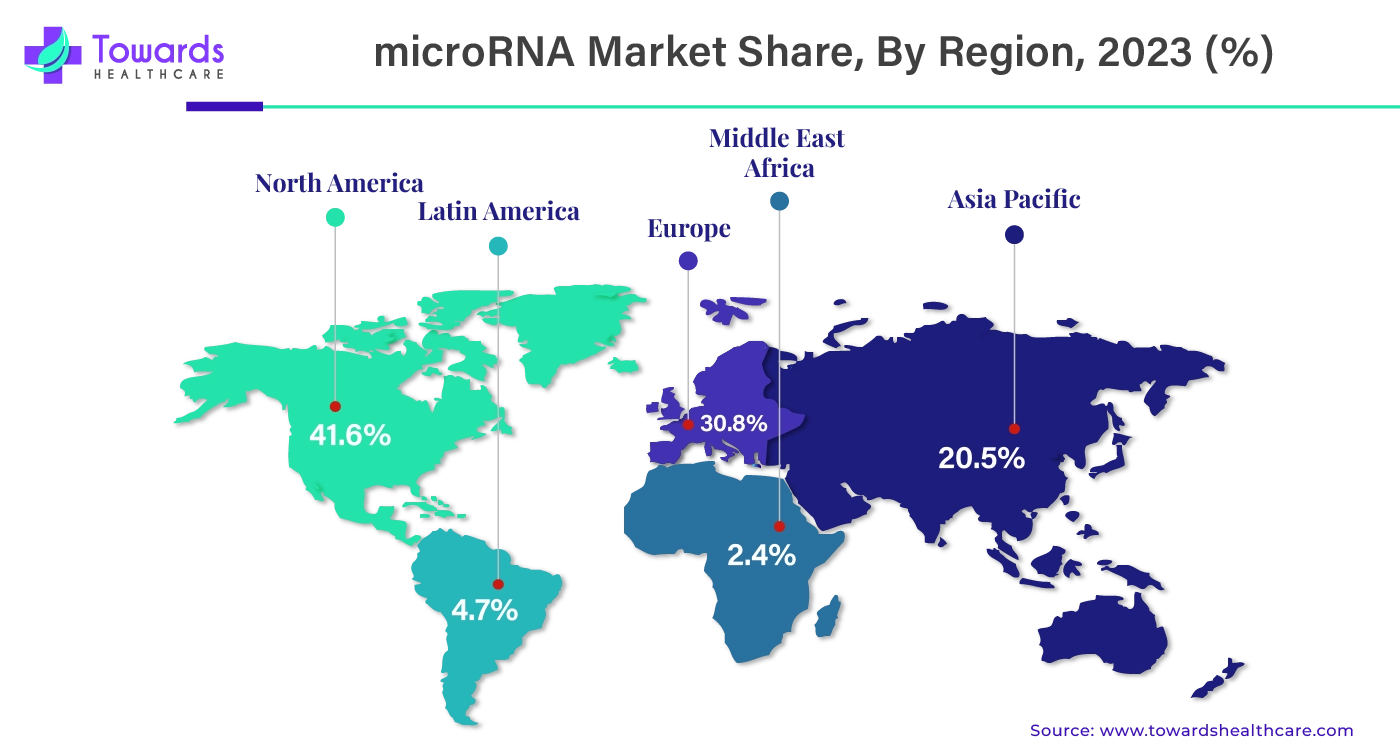December 2024

The global microRNA market was estimated at US$ 1.61 billion in 2023 and is projected to grow to US$ 6.11 billion by 2034, rising at a compound annual growth rate (CAGR) of 12.89% from 2024 to 2034. The increasing prevalence of chronic conditions is driving the market’s growth.

The term "microRNA market" refers to the dynamic and quickly growing area of the biotechnology and life sciences industries that is focused on the discovery, creation, and promotion of goods and technologies based on microRNA. MicroRNAs are short, non-coding RNA molecules that are extremely conserved and have a role in controlling the expression of certain genes. miRNA is primarily involved in the control of genes. Numerous illnesses can be treated by using miRNA as targets or instruments. miRNA controls a large number of genes involved in DNA repair. In addition to identifying the diagnostic, prognostic, and/or predictive value of individual microRNAs or microRNA signatures as potential biomarkers for patient management, this enormously large body of research has produced innovative technological advancements for the detection of microRNAs in tissue and bodily fluids.
Advances in biomedical informatics' machine learning field have made it possible to investigate medications that target miRNA, therefore advancing the field of miRNA therapies. Additionally, the outcomes of machine learning models' predictions might be contrasted with miRNA-disease/drug connections that have been confirmed by experimental means. The lack of data available for building trustworthy prediction models may be addressed by machine learning techniques like active learning. Machine learning fairness is a recently developed subject that aims to investigate the impact of model and data biases, such as gender, ethnicity, and disability, on the prediction performance of miRNA treatment.
For instance,
| Company Name | DiamiR Biosciences |
| Headquarters | NJ, U.S., North America |
| Recent Development | In July 2024, the diagnostics company DiamiR Biosciences is getting ready to launch its microRNA-based CogniMir blood test for Alzheimer's risk assessment in late 2023 or early 2024 after conducting a clinical trial on it. In the long term, the company intends to make CogniMir—which measures the expression of 24 microRNA targets in plasma using PCR—the focal point of a broader clinical offering related to Alzheimer's disease. This offering will comprise assays based on the company's microRNA technology in addition to protein and other tests obtained from other suppliers. |
| Company Name | MiRecule |
| Headquarters | Gaithersburg, U.S., North America |
| Recent Development | In July 2024, Sanofi and miRecule, a developer of RNA treatments, are working together to create a therapy for facioscapulohumeral muscular dystrophy, or FSHD. MiRecule, the winner of MedCity News's Pitch Perfect company competition in the biopharma category, is currently looking to raise capital in a Series A round. |

Because miRNAs can be used as therapeutic targets in clinical settings, research on them has been concentrated. Numerous clinical trials employing miRNAs for medication testing, diagnosis, and screening are now in progress. Biopharmaceutical firms are becoming more involved in this dynamic sector, and current clinical studies suggest that anti-miR and miR-mimic medicines represent a new class of compounds with potential therapeutic uses in the future. Clinical trials for nearly all human disorders are focusing on the therapeutic potential of miRNA therapies.
For instance,
It is still difficult to determine the efficacy and safety of miRNA-based therapies, particularly those that aim to target human tissues via the administration of miRNA mimics or antagomirs. MiRNA delivery techniques have some disadvantages, including a weak binding affinity for complementary sequences, fast clearance from blood, toxicity that occurs off-target, vulnerability to nucleases upon introduction into biological systems, and off-target toxicity. Moreover, they may induce involuntary gene silencing because they target many pathways through imprecise matching in the 3′ UTR region.
These short RNAs offer themselves for therapeutic reasons toward a focused alteration of cell processes that are critical to a disease phenotype, in addition to the diagnostic potential of changed miRNA expression levels. Understanding the functions of miRNAs in development and illness, especially cancer, has made miRNAs desirable targets and instruments for cutting-edge treatment strategies. Numerous treatments targeting miRNA have advanced to the clinical stage. Consequently, substantial expenditures have been made in the development of miRNA-based therapeutics by multidisciplinary sectors spanning biology, chemistry, and medical research.
| Sr. No. | miRNA Therapeutics in the Preclinical Stage | miRNA Therapeutics in Clinical Stage |
| 1. | RG-012 | miR-10b |
| 2. | MGN-1347 | INT-1B3 |
| 3. | MGN-2677 | AMT-130 |
| 4. | MGN-4220 | RGLS4326 |
| 5. | MGN-4893 | MRG-110 |
| 6. | MGN-5804 | MesomiR-1 |
| 7. | MGN-6114 | CDR132L |
| 8. | MGN-9103 | RG-101 |
| 9. | MRG-107 | MRX34 |
| 10. | -- | miR-10 |
By products & services, the service segment held the largest share of the microRNA market in 2023. There are different types of services associated with microRNA. Each service has different roles. Quantification of customer-provided total RNA or microRNA samples is included in the microRNA sequencing services, which also comprise microRNA library creation, cluster production, and sequencing. From sample extraction to data processing, CD Genomics' microRNA sequencing service provides complete and integrated services. Quality control for sample extraction, sequencing, library preparation, bioinformatics analysis, and data reporting are all included in the service.

By application, the cancer segment dominated the microRNA market in 2023. Nowadays, cancer is one of the major issues. Researchers are always looking for novel elements that contribute to the carcinogenesis process. miRNAs are thought to be possible cancer indicators. First, because miRNA molecules are found in a variety of bodily fluids, they are easily accessible for research. Second, miRNAs' great biological stability makes it easier to discover them. Third, miRNAs exhibit tissue-specific expression in many situations and control all phases of tumor formation.
For instance,
By application, the infectious diseases segment is anticipated to grow at the fastest rate in the microRNA market during the forecast period. Because extracellular miRNAs can be extracted from bodily fluids, they are excellent biomarker candidates. Ex-miRNAs in patient samples might be quantified using RT-PCR, which is currently often utilized in the clinical environment to rapidly detect infections (e.g., respiratory infections in newborns with bronchiolitis). According to a number of recent research, miRNAs have a critical role in controlling immune cell differentiation, maturation, and activation, which in turn affects how the host immune system responds to infection. miRNAs have been investigated recently in a variety of infectious illnesses as therapeutic targets and diagnostic indicators.

By end-use, the biotechnology & pharmaceutical companies segment dominated the microRNA market in 2023. The main function of microRNA is in therapeutics and various sequencing-associated activities. Both biotechnology and pharmaceutical companies are highly invested in the development of new therapeutics and understanding the function of genes. As the population grows, unhealthy lifestyles and environmental conditions contribute to chronic conditions, pharma, and biotech companies are conducting clinical trials and research studies. Companies are heavily investing and collaborating with other companies and government institutions to come up with better solutions.
For instance,

North America dominated the microRNA market share by 41.6% in 2023. because there is a robust biotechnology and pharmaceutical sector, a well-established healthcare infrastructure, and large expenditures in research and development. Numerous industry participants and university research centers actively involved in miRNA research are based in the region. The availability of cutting-edge technology, collaborative efforts between academia and business, and supportive government initiatives all contribute to North America's commercial supremacy in the microRNA market.
For instance,
By region, Asia Pacific is expected to grow at the fastest rate during the forecast period. Some of the factors propelling the microRNA market expansion in the area include the rapidly expanding population, an increase in the prevalence of cardiovascular illnesses, a greater demand for microRNA-based treatments, and a stronger focus on research and development initiatives.
For instance,
China has been a popular complementary and alternative medicine for the treatment of cancer in recent decades. MicroRNAs, or miRNAs, have been intensively studied for their potential to target miRNAs and play essential roles in several pathological processes, including cancer. Additionally, Chinese medicinal herbs have been proven to have anti-cancer properties through miRNA targeting. Drawn from the root of Coptis chinensis, berberine is a well-known herbal remedy with anti-cancer properties.
By Products & Services
By Application
By End-use
By Region
December 2024
December 2024
December 2024
December 2024